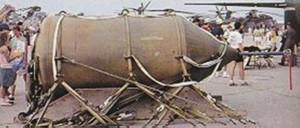Daisy Cutter

A BLU-82 with the probe on the nose (to the right) which would detonate the bomb a few feet above the ground
This term seems to have originated in early baseball or cricket, referring to a ball that travels low across the ground – either a cricket bowl or a baseball hit. Presumeably, the name comes from the idea that the ball was low enough to “cut daisies” as it traveled.
From there, it morphed into munitions. A fuse was developed that allowed bombs to explode just before they hit the ground, which means the blast didn’t get absorbed by the Earth and instead spread out over a larger area. So, like the ball described above, the blast of the bomb skimmed over the top of the ground.
These bombs were often used to clear areas for helicopter landing zones, as they would fell trees in a wide radius without leaving a crater. This culminated in the famous BLU-82 bomb used in Vietnam, which was nicknamed “The Dasiy Cutter.”
This video shows the bomb dropped in a forest to clear an area for a helicopter to land.
The U.S. produced just over 200 BLU-82 bombs, starting in the late 1960s. They were used during Vietnam, the Gulf War, and as late as the war in Afghanistan. No operational BLU-82s remain.
Why I Looked It Up
In The Kaiju Preservation Society, characters discussed using “lots and lots of daisy cutters,” for a specific tactical situation, instead of nuclear weapons, because the latter would open up the rift between worlds. The implication being that daisy cutters were the only comparable conventional weapons. (Notably, it was in lower case, not title case, like it would be if referring to the BLU-82 as a proper noun.)
I had heard of that phrase used for the BLU-82, but I wasn’t sure if it was a general phrase, or where it originated.